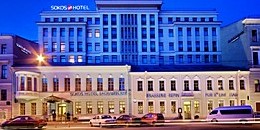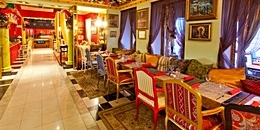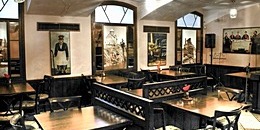Nabereznaya Leitenanta Schmidta (Lieutenant Schmidt Embankment)
As a continuation of the famous Universitskaya Embankment, Lieutenant Schmidt Embankment also boasts many old buildings that have stood here since the earliest years of St. Petersburg. Extra charm is added by the broad expanses of the Neva River, which is deep enough here to receive large sea ships. For many who came to Saint Petersburg in the 19th and 20th centuries, their new experience began on this waterfront.
At the beginning of the 18th century, the entire southern shore of Vasilevsky Island was called the Bolshoy Neva Embankment. Here stood not only palaces for the nobility, but also more modest homes built to templates by the French architect Jean-Baptiste Leblond. These include the Esterreykh Mansion (No. 3), the Umnova House (No. 5), and the Keyserling House (No. 7). A peculiar feature of these structures on what was to become the Lieutenant Schmidt Embankment is that the houses are all tiered following the lines of the concave river banks of the Neva.

In 1758, the architect Savva Chevakinsky constructed a building (No. 1) on the waterfront which would go on to become the most famous residential building in the history of Russian science. For two hundred years, more than fifty distinguished scholars and teachers lived here and worked nearby at the Academy of Sciences and Saint Petersburg State University. Twenty-nine of them are named on memorial plaques on the walls of the building, and a memorial museum was established for the renowned physiologist Ivan Pavlov in what came to be known as the House of Academics. Another world-famous scientist and mathematician, Leonhard Euler, lived nearby in house No. 15 from 1766 to 1783.
At the end of the 18th century, the Naval Cadet Corps (now the Peter the Great Naval Corps and Institute of St. Petersburg) was built on the embankment. Graduates include the famous Russian admirals Pavel Nakhimov; Vladimir Kornilov; Vladimir Istomin; the discoverers of Antarctica Thaddeus Bellingshausen and Mikhail Lazarev; the composer Nikolay Rimsky-Korsakov; and the artist Vasily Vereshchagin. In front of the building stands a monument to Ivan Krusenstern, long-term director of the Naval Admiralty and head of the first Russian circumnavigation of the globe.
In 1773, the Mining College opened at the western end of the embankment and became the first such institution in Russia and only the second in the world. In 1806-1811 the famous architect Andrew Voronikhin, designer of the Kazan Cathedral, constructed a building for the college in high neoclassical style, with a magnificent twelve-columned portico. Sculptures flanking the entrance were created by Stepan Pimenov, while bas-reliefs on mythological subjects were carried out by Vasily Demut-Malinovsky. In 1866, the Mining School was renamed the Mining Institute. It is still in operation today.

In the middle of the 19th century the embankment was reinforced with granite. In 1843-1850 the Annunciation Bridge was built, though it was originally known as Nicholas Bridge from 1855-1918. This was the first permanent bridge across the Neva River in St. Petersburg. All along the embankment piers and other moorings were built which entailed extending the embankment into the river by 26 meters. During the winter, training frigates were laid up here, while in the summer months, passenger vessels from Kronstadt, Stockholm, and Helsinki anchored here. After 1900, these vessels were welcomed by the five-domed Church of the Dormition built in the Russian Revival style by Vasily Kosyakov, architect of the Naval Cathedral in Kronstadt.
In 1859, the first horse-drawn railway in St. Petersburg appeared on the embankment. In 1887, the segment between 7th Line and 23rd Line of Vasilievsky Island received independent embankment status and was originally named in honor of the Nikolaevsky Bridge where the embankment starts. Thirty years later, after the Bolshevik Revolution, it was renamed in honor of Lieutenant Pyotr Schmidt, a graduate of the Naval Cadet Corps who took an active part in the uprising of the Black Sea Fleet in 1905.
Today, a variety of vessels continue to moor along the Lieutenant Schmidt Embankment. In 1996, the historic icebreaker Krasin was moored here permanently. It was built in 1916 and won international fame after rescuing the crew of Umberto Nobile's zeppelin Italia. Today it is the world's only icebreaker in the world to house a museum.
| Metro stations: | Vasileostrovskaya |
|---|---|
| Directions: | Exit Vasileostrovskaya metro station, turn right and walk along the 6th Line to Ploshchad Trezzini, where the embankment begins. |
| Best walking route: | All the embankment (1 hour) |
| What's here? | House of Academics, The Mining Institute / Mining Museum, Krasin Icebreaker, Church of the Dormition |
| What's nearby? | Universitskaya Naberezhnaya (University Embankment), Blagoveschensky (Annunciation) Bridge, 6th and 7th Lines, Neva River |







